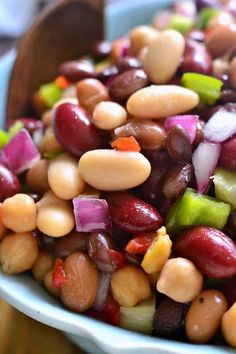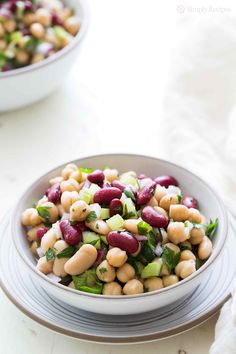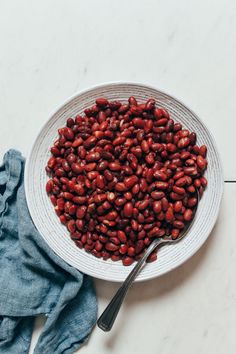Beans (Red) Vs. Beans (Kidney)

Beans are available in various sizes, colors, forms, and tastes. They are a kind of legume high in vitamins, minerals, and proteins and are used in various cuisines. They are available fresh, dried, or canned. They all have various textures and tastes, and each requires a different way of cooking. Red beans and kidney beans are not all the same thing. However, because they resemble each other, they are frequently mistaken. Red beans are round and smaller than kidney beans, with a pale red, almost pink color, and a smooth, creamy, silky texture. They complement a variety of Creole and Southern cuisines, including salads, soups, chili con carne, and the classic red beans and rice.
Kidney beans come in various colors and sizes:
- Red kidney beans
- White kidney beans
- Red speckled kidney beans
- Faintly speckled kidney beans
Red kidney beans are larger than red beans, have a deeper red hue, and are shaped like a kidney. They also have thicker skin than red beans and are cooked for a longer period, allowing them to absorb the flavors of the other components in the meal. Kidney beans are commonly used in jambalaya, chili, baked beans, soups, stews, salads, and rice dishes. Before using, they should be soaked and thoroughly cooked because kidney beans contain a harmful protein removed during soaking and boiling.
Red Beans vs. Kidney Beans Nutrition
Red beans and kidney beans are high in nutrients. According to Web MD, Kidney beans offer critical elements beneficial to people’s health. Iron, manganese, folate, phosphorus, and thiamine are all found in kidney beans. One cup of canned kidney beans includes 219 calories, 16.2 grams of protein, and 16.5 grams of fiber. Red beans are also high in magnesium, potassium, calcium, protein, and fiber. One cup of canned red beans has 17.3 grams of protein, 16.8 grams of fiber, and 294 calories. Red beans and kidney beans are high in plant-based protein and fiber, making them ideal for vegans and vegetarians. They are abundant in vitamins, minerals, antioxidants, fiber, and other essential nutrients. Thus they can aid with a variety of health issues. They are beneficial for diabetes, high cholesterol, and weight reduction. The nutritional values of 1 cup cooked red beans and kidney beans are shown in the table below. The proportion varies based on the kind and brand of red and kidney beans.
Can you Substitute Kidney Beans for Red Beans?

Because they have similar nutritional content, you may swap kidney beans for red beans even if they have a similar flavor. To minimize any unfavorable side effects, carefully cook the dry kidney beans. To prepare kidney beans, the FDA recommends the following steps. Allow the kidney beans to soak for at least 5 hours, ideally overnight. Remove the kidney beans from the water and set them aside. Place the kidney beans in a pot with cold water after rinsing them. Cook the kidney beans for 10–30 minutes at 212°F. Reduce the heat and cook the kidney beans until they are tender and well cooked. Cooked kidney beans can be used in curries, salads, soups, and a variety of other recipes.
Is it better to eat red beans or kidney beans?
They are both high in vitamins, minerals, antioxidants, and other substances beneficial to health. In stews and rice dishes and several other recipes, red beans and kidney beans can be used interchangeably. It is up to you and the sort of meal you are cooking to decide which one to use. Kidney beans have stricter skin than red beans, are best utilized in long-cooked meals. On the other hand, red beans have a velvety texture that complements chili, soup, and rice dishes.
Does Another Name know red Beans?
Red beans are often referred to as Mexican red beans or just red beans.
Do Kidney Beans Have a Taste Similar to Red Beans?

Kidney beans are not the same as red beans. Red beans have a somewhat nutty flavor, whereas kidney beans absorb the flavors of the other components in the meal.
What Is the Distinction Between Red and Chili Beans?
Chili beans are often made from kidney beans. Pinto and black beans, on the other hand, may be used to produce chili beans. They’re made with chili sauce and eaten with rice, in a burrito, with cornbread, or with corn tortillas. Red beans are similar to pinto beans in appearance. They both have a rich, silky, and creamy flavor, but they are not the same hue. Red beans are a bright red, nearly pink hue when dry, whereas pinto beans are a beige tint with brown-red specks when dry, turning light brown or pale pink when cooked.
For chili, should you use red beans or kidney beans?
Pinto beans, kidney beans, red beans, black beans, and fava beans are common chili beans. Which one you use in your chili is entirely up to you. Red beans or pinto beans can be used to get a smooth and creamy texture. On the other hand, kidney beans are firmer and do not dissolve when cooking. You may also add kidney and red beans to your chili to make it thicker and more flavorful.
Conclusion
There are several varieties of beans available on the market. There are, however, beans that appear identical but have distinct tastes and textures, such as red beans and kidney beans. They have a similar appearance but differ in flavor. Therefore they are frequently confused for one another. If you can’t decide between red beans and kidney beans, try both and discover which one pairs best with your taste. But, no matter what you pick, your food will be full of taste and healthy nutrients for your health. Red beans and kidney beans are high in important vitamins, minerals, antioxidants, protein, and fiber, which can aid you with various health issues. To avoid food poisoning, all you have to do is properly prepare them. We hope we were able to assist you in deciding which beans to use in your chili, salad, or rice meal.











